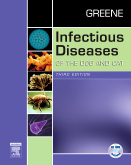|
|
|
| |
 |
|
|

|
 推薦指數:
推薦指數:





|
|
- 內容介紹
|
Infectious Diseases of the Dog and Cat - Revised Reprint, 3rd Edition
By Craig E. Greene, DVM, MS, DACVIM
Dr. Greene is the recipient of the 2005 Mark L. Morris, Sr. Lifetime Achievement Award!
1424 pages 400 ills
Trim size 8 1/2 X 10 7/8 in
Copyright 2006
Description
This indispensable resource explores the diagnosis and treatment of canine and feline infectious diseases. Disease coverage includes those caused by viruses, rickettsiae, chlamydias, mycoplasmas, bacteria, fungi, algae, protozoa, and unknown agents. Each disease is accompanied by discussions of diagnostic testing, indications and methods for sample collection and laboratory submission, interpretation of results, and performance of in-office diagnostic procedures. The book includes indications and pharmacologic considerations of antimicrobials used to treat various infections, with coverage of the clinical problems related to infectious diseases, such as environmental control of infections, immunodeficiency disorders, prevention of infection in communal environments, immunocompromised people and pets, and immunization. Also features a complete antimicrobial drug formulary, drug dosage tables, prescribing information, immunization recommendations, and a list of product manufacturers.
Key Features
An accompanying CD-ROM provides easy access to an extensive list of references for further research.
A complete list of acronyms is located on the front cover for quick access to the meanings of all acronyms featured in the book.
Provides complete and consistent prescribing information in easy-to-use drug dosage tables.
A comprehensive drug formulary in the appendix provides key information on each drug to help adjust dosages on the basis of clinical and toxicologic data.
New to this Edition
Includes coverage of newly discovered infectious agents of dogs and cats, including diagnosis and treatment considerations.
Provides the latest information on foot and mouth disease virus infection.
Contains up-to-date information on Australian bat lyssavirus infection in the Rabies chapter.
Offers additional information on canine monocytic and granulocytic ehrlichiosis.
This edition features full-color illustrations and a user-friendly layout.
Table of Contents
1. Laboratory Diagnosis of Viral and Rickettsial Infections and Epidemiology of Infectious Disease 2. Antiviral and Immunodulatory Chemotherapy 3. Canine Distemper 4. Infectious Canine Hepatitis and Canine Acidophil Cell Hepatitis 5. Canine Herpesvirus Infection 6. Canine Infectious Tracheobronchitis 7. Nonrespiratory Parainfluenza Virus Infection of Dogs 8. Canine Viral Enteritis 9. Canine Viral Papillomatosis 10. Feline Parvoviral Infections 11. Feline Coronavirus Infections 12. Feline Enteric Infections 13. Feline Leukemia Virus Infection 14. Feline Immunodeficiency Virus Infection 15. Feline Adenovirus Infection 16. Feline Respiratory Disease 17. Feline Foamy (Syncytium-Forming) Virus Infection 18. Feline Paramyxovirus Infections 19. Poxvirus Infection 20. Feline Viral Papillomatosis 21. Miscellaneous Viral Infections 22. Rabies and Other Lyssavirus Infections 23. Pseudorabies 24. Enterovirus Infections 25. Mumps and Influenza Virus Infections 26. Arthropod-Borne Viral Infections 27. Salmon Poisoning Disease 28. Ehrlichiosis, Neorickettsiosis, Anaplasmosis, and Wolbachia Infection 29. Rocky Mountain Spotted Fever, Murine Typhus-Like Disease, Rickettsialpox,Typhus, and Q Fever 30. Chlamydial Infections 31. Hemotropic Mycoplasmosis (Haemobartonella) 32. Mycoplasmal, Ureaplasmal and L-Form Infections 33. Laboratory Diagnosis of Bacterial Infections 34. Antibacterial Chemotherapy 35. Streptococcal and Other Gram-Positive Bacterial Infections 36. Staphylococcal Infections 37. Gram-Negative Bacterial Infections 38. Endotoxemia 39. Enteric Bacterial Infections 40. Canine Brucellosis 41. Anaerobic Infections 42. Botulism 43. Tetanus 44. Leptospirosis 45. Borreliosis 46. Miscellaneous Bacterial Infections 47. Plague 48. Tularemia 49. Actinomycosis and Nocardiosis 50. Mycobacterial Infections 51. Feline Abscesses 52. Bite Wound Infections 53. Bartonellosis 54. Surgical and Traumatic Wound Infections 56. Laboratory Diagnosis of Fungal and Algal Infections 57. Antifungal Chemotherapy 58. Dermatophytosis 59. Blastomycosis 60. Histoplasmosis 61. Cryptococcosis 62. Coccidioidomycosis 63. Sporotrichosis 64. Rhinosporidiosis 65. Aspergillosis and Penicilliosis 66. Candidiasis, Torulopsosis, and Rhodotorulosis 67. Trichosporonosis 68. Miscellaneous Fungal Infections 69. Protothecosis 70. Laboratory Diagnosis of Protozoal Infections 71. Antiprotozoal Chemotherapy 72. Trypanosomiasis 73. Leishmaniasis 74. Hepatozoonosis 75. Encephalitozoonosis 76. Cytauxzoonosis 77. Babesiosis 78. Enteric Protozoal Infections 79. Acanthamebiasis 80. Toxoplasmosis and Neosporosis 81. Enteric Coccidiosis 82. Cryptosporidiosis and Cyclosporiasis 83. Pneumocystosis 84. Neurologic Diseases of Suspected Infectious Origin 85. Integumentary Infections 86. Musculoskeletal Infections 87. Cardiovascular Infections 88. Respiratory Infections 89. Gastrointestinal and Intra-Abdominal Infections 90. Hepatobiliary Infections 91. Genitourinary Infections 92. Central Nervous System Infections 93. Ocular Infections 94. Environmental Factors in Infectious Disease 95. Immunodeficiencies and Infectious Diseases 96. Fever 97. Prevention and Management of Infection in Catteries 98. Prevention and Management of Infection in Kennels 99. Immunocompromised People and Pets 100. Immunoprophylaxis and Immunotherapy
|
|
|

